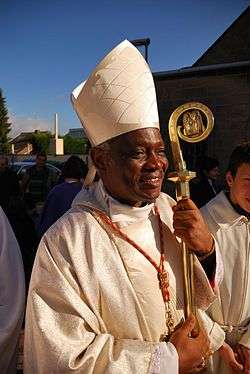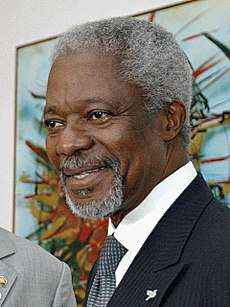Fante people
The Mfantsefo or Fante ("Fanti" is an older spelling) are an Akan people. The Fante subgroup is mainly gathered in the central coastal region of Ghana, with some also in Ivory Coast. Originally, "Fante" referred to "the half that left" and initially settled at Mankessim.[1] The states that made up the Fante were Kurantsi, Abura,[2] Anyan, Ekumfi, Nkusukum, Ajumako and Gomoa.
| Total population | |
|---|---|
| ~3,500,000 | |
| Regions with significant populations | |
| Central region, Western region | |
| Languages | |
| Fante English | |
| Religion | |
| Christianity, Akan religion | |
| Related ethnic groups | |
| Akan |
The main Fante city is Cape Coast, Central region, and Mankessim is the traditional headquarters. The Fante people are one of the Akan group, along with the "Asantefo" or Ashantis, the Akuapem, the Akyem, the Bono, the Baoule, Nzema, and others. Despite the rapid growth of the Ashanti Empire in historic times, the Fante have always retained their state to this day. Currently, they number about 3.5 million, the second largest grouping of Akan peoples. Inheritance and succession to public office among the Fante are traditionally determined by matrilineal descent, as is common among Akan peoples.
When the Portuguese arrived in the 15th century, the Fante prevented them from venturing inland and leased properties for Portuguese trading missions. But when the Portuguese objected to Fante rules and regulations, the Fante expelled them. Thereafter the Dutch arrived, followed by the British. The Fante served as middlemen in the commerce between the interior and British and Dutch traders on the coast.
In the early 18th century, the Fante Confederacy was formed, with the aim of establishing themselves as a nation to be taken seriously by their European counterparts. So in 1844 a bond was written between the Fante, on behalf of the Gold Coast, and the British, allowing the Gold Coast to gain independence without war one hundred years later. Several Ashanti-Fante wars followed. On one occasion, the Fante were aided by the British, who, however, destroyed the strong Fante confederation established between 1868 and 1872, believing it a threat to their hegemony on the coast.
The Fante have produced numerous illustrious and prominent people, notable among whom are Kofi Annan (former UN Secretary General), Jacob Wilson Sey (first indigenous multimillionaire on the Gold Coast), British journalist and writer Ekow Eshun, Ottobah Cugoano (abolitionist and natural rights philosopher), Sam Jonah (ex-CEO of AngloGold Ashanti), John Atta Mills (Ghana's late former president), Kwesi Amissah-Arthur (Ghana’s late former vice president), and a number of the advocates of independence, not only in Ghana but also in the West African sub-region, such as John Mensah Sarbah, James Kwegyir Aggrey and J. E. Casely Hayford.
Family names
One of the social contexts of names among the Akan, including the Fante, is that they are used as social tags to indicate personal and group identity. This is so with family names derived from the patrilineal clans of the fathers that are given to children. Each of the 12 patrilineal clans has its peculiar family names. It is thus possible to use one’s name to trace his/her patrilineal clan. Children who trace their genealogy to one patrilineal father may therefore share similar family names.[3] Typical family names include Yankah, Osam, Aidoo, etc. There have also been innovations as a result of westernisation, education and foreign religion. Multiple names have also developed out of this phenomenon. Also, some Fante names are translated literally into English and such anglicised names have come to stay as family names. One can argue that the Fantes living on the coast were the first to be in contact with the Europeans. It is therefore possible that the trend is a western influence. Examples of such anglicised transformational name are:
- Dua (lit tree/board) – Wood
- Kuntu (blanket ) – son of Kuntu Blankson
- Kumi ba (child of Kumi) – Kumson or Koomson
- Kwei ba (child of Kwei) – Quayson, Quayeson, Kweison or Kwaeson
- Akorɔma (hawk) – Hawkson
- Nyameba – Godson
- ɛbo (stone) – Rockson
Accordingly, some family names can also be identified by the suffix, for example:
- -son as in Yawson
- -ful, as in Arkorful,
- -ney, as in Biney.
Otherwise, Fante (Akan) typological family names indicate various contexts. They may be circumstantial, manner of birth, theophorous, weird names, insinuating and proverbial names, gang and nicknames, status, occupational, professional, religious, matrimonial, and western names. There can be a combination of two or more of these typological names.
Naming system
Fantes use a system of giving the first name to a child based on the day of the week that the child was born:[4]
| Day | Male Name | Female Name |
|---|---|---|
| Dwowda (Monday) | Kodwo, Kojo, Joojo/Jojo | Adwoa/Adwowa, Ewuradwoa |
| Benada (Tuesday) | Kobina, Kobby | Abena, Araba, Ewurabena |
| Wukuda (Wednesday) | Kweku, Kuuku | Ekua, Kuukua, Ewurakua |
| Yawda (Thursday) | Yaw, Ekow, Kow | Aba, Baaba |
| Fida (Friday) | Kofi, Fiifi | Efua, Effie, Ewurafua |
| Memenda (Saturday) | Kwame, Kwamena, Ato | Ama, Ewurama |
| Kwesida (Sunday) | Kwesi, Siisi | Esi, Ewuresi/Ewuraesi |
Children may also be named according to the sequence in which they are born. The names given are as follows:
| Position | Male Name | Female Name |
|---|---|---|
| First | Piesi | Piesi |
| Second | Manu | Abena, Araba, Ewurabena |
| Third | Mensa, Ansa | Mansa, Naana |
| Fourth | Maanan | Maanan |
| Fifth | Enum | - |
| Sixth | Esia | - |
| Seventh | Esuon | - |
| Eighth | Awotwe | - |
| Tenth | Badu | Baduwa |
Twins may also be named according to the sequence in which they are born. The names given are as follows:
| First Twin | Second Twin | |
|---|---|---|
| <Given Day Name> Payin | <Given Day Name> Kaakra |
The next child born immediately after the birth of the twins may be given a name, such as:
| Example Male | Example Female |
|---|---|
| Kojo Tewia or Kojo Tewiah | Ekua Tewia or Ekua Tewiah |
Origin
According to oral tradition the Fante separated from the Bono people, around 1250 AD. This act became the origin of their name, "Fa-atsew" meaning "half that left". The Fante left their Bono brethren at Krako, present day Techiman in the Bono East of Ghana, and became their own distinct Akan group. The Fante people were led by three great warriors known as Obrumankoma, Odapagyan and Oson (the whale, the eagle and the elephant respectively).
According to tradition, Obrumankoma and Odapagya died on this exodus and were embalmed and carried the rest of the way. Oson led the people to what would become Mankessim in 1252. Legend has it that the Fante's chief priest, Komfo Amona, planted a spear in the ground when they reached the location of the settlement. The spear is called the Akyin-Enyim, meaning "in front of god". The place became the meeting place for the Fante elders and the head fetish priest when discussing important matters.
The first Omanhen (king) of Mankessim was installed here, and later kingmakers would visit the site for consultation. According to the Fante, the spear cannot be removed by mortal hands. The land the Fante reached was initially called Adoakyir by its existing inhabitants, which the Fante called "Etsi-fue-yifo" meaning people with bushy hair. The Fante conquered these people and renamed the settlement Oman-kesemu, meaning large town. The name has evolved into the current name, Mankessim.
The Fante settled the land as their first independent kingdom, and buried Obrumakankoma and Odapagya in a sacred grove called Nana-nom-pow. Komfo Amona also planted the limb of a tree he had brought from the Akan homeland in Krako to see if a place was good for settlement. The day after the priest planted the limb, the people found a tree starting to grow. The tree was named Ebisa- dua, or the consulting tree, and its location is today one of the most important shrines in Mankessim.[1]
References
- Rebecca Shumway. 2011. "The Fante and the Transatlantic Slave Trade." Rochester: University of Rochester Press. ISBN 978-1580463911
- Adu Boahen, Fante origins: The Mankessim period in " A Thousand years of West African History", 1968pp. 180-1820.
- Facts On File, Incorporated (2009). Encyclopedia of the Peoples of Africa and the Middle East. Infobase Publishing. pp. 4–. ISBN 978-1-4381-2676-0.
- http://www.njas.helsinki.fi/pdf-files/vol15num2/agyekum.pdf
- "'Day born names' in Dagbani, Ewe and Fante". www.ghanaweb.com. Retrieved 2019-12-23.
This article incorporates text from a publication now in the public domain: Wood, James, ed. (1907). "article name needed". The Nuttall Encyclopædia. London and New York: Frederick Warne.


